Ellagitannin Oligomers from Eucalyptus camaldulensis Leaves and Their Role in the Detoxification of Aluminum
Abstract
1. Introduction
2. Results and Discussion
2.1. Isolation and Structural Elucidation of Novel and Known Compounds
2.2. Detoxification of Al
3. Materials and Methods
3.1. Instrumentation
3.2. Plant Material
3.3. Extraction and Isolation
3.4. Bioassay for Detoxification Studies
4. Conclusions
Supplementary Materials
Author Contributions
Funding
Institutional Review Board Statement
Informed Consent Statement
Data Availability Statement
Acknowledgments
Conflicts of Interest
Abbreviations
| HPLC | High-performance liquid chromatography |
| HR–ESI–MS | High-resolution electrospray ionization mass spectrometry |
| NMR | Nuclear magnetic resonance |
| HHDP | Hexahydroxydiphenoyl |
| COSY | Correlation spectroscopy |
| HMBC | Heteronuclear multiple bond correlation |
| CD | Circular dichroism |
| UV | Ultraviolet |
| HSQC | Heteronuclear single quantum correlations |
| TLC | Thin layer chromatography |
References
- Hirsch, H.; Allsopp, M.H.; Canavan, S.; Cheek, M.; Geerts, S.; Geldenhuys, C.J.; Harding, G.; Hurley, B.P.; Jones, W.; Keet, J.-H.; et al. Eucalyptus camaldulensis in South Africa—Past, present, future. Trans. R. Soc. S. Afr. 2020, 75, 1–22. [Google Scholar] [CrossRef]
- Sabo, A.V.; Knezevic, P. Antimicrobial activity of Eucalyptus camaldulensis Dehn. plant extracts and essential oils: A review. Ind. Crops Prod. 2019, 132, 413–429. [Google Scholar] [CrossRef] [PubMed]
- Kochian, L.V.; Piñeros, M.A.; Liu, J.P.; Magalhaes, J.V. Plant adaptation to acid soils: The molecular basis for crop aluminum resistance. Annu. Rev. Plant Biol. 2015, 66, 571–598. [Google Scholar] [CrossRef]
- Ikkaa, T.; Ogawa, T.; Lia, D.; Hiradateb, S.; Morita, A. Effect of aluminum on metabolism of organic acids and chemical forms of aluminum in root tips of Eucalyptus camaldulensis Dehnh. Phytochemistry 2013, 94, 142–147. [Google Scholar] [CrossRef]
- Marsh, K.J.; Kulheim, C.; Blomberg, S.P.; Thornhill, A.H.; Miller, J.T.; Wallis, I.R.; Nicolle, D.; Salminen, J.P.; Foley, W.J. Genus-wide variation in foliar polyphenolics in eucalypts. Phytochemistry 2017, 144, 197–207. [Google Scholar] [CrossRef]
- Sani, I.; Abdulhamid, A.; Bello, F. Eucalyptus camaldulensis: Phytochemical composition of ethanolic and aqueous ex-tracts of the leaves, stem-bark, root, fruits and seeds. J. Sci. Innov. Res. 2014, 3, 523–526. [Google Scholar] [CrossRef]
- Tahara, K.; Hashida, K.; Otsuka, Y.; Ohara, S.; Kojima, K.; Shinohara, K. Identification of a hydrolyzable tannin, oenothein B, as an aluminum-detoxifying ligand in a highly aluminum-resistant tree, Eucalyptus camaldulensis. Plant Physiol. 2014, 164, 683–693. [Google Scholar] [CrossRef]
- Yoshida, T.; Yoshimura, M.; Amakura, Y. Chemical and Biological Significance of Oenothein B and Related Ellagitannin Oligomers with Macrocyclic Structure. Molecules 2018, 23, 552. [Google Scholar] [CrossRef]
- Yoshida, T.; Hatano, T.; Ito, H. Chemistry and function of vegetable polyphenols with high molecular weights. BioFactors 2000, 13, 121–125. [Google Scholar] [CrossRef]
- Yoshida, T.; Chou, T.; Nitta, A.; Okuda, T. Tannins and related polyphenols of lythraceous plants. III. Hydrolyzable tannin oligomers with macrocyclic structures, and accompanying tannins from Woodfordia fruticosa KURZ. Chem. Pharm. Bull. 1992, 40, 2023–2030. [Google Scholar] [CrossRef]
- Okuda, T.; Yoshida, T.; Ashida, M.; Yazaki, K. Tannis of Casuarina and Stachyurus species. Part 1. Structures of pedunculagin, casuarictin, strictinin, casuarinin, casuariin and stachyurin. J. Chem. Soc. Perkin Trans. 1983, 1, 1765–1772. [Google Scholar] [CrossRef]
- Wilkins, C.; Bohm, B. Ellagitannins from Tellima grandiflora. Phytochemistry 1976, 15, 211–214. [Google Scholar] [CrossRef]
- Yakubu, F.O.; Adebayo, H.A.; Dokunmu, M.T.; Zhang, Y.; Iweala, E.J.E. Cytotoxic Effects of Compounds Isolated from Ricinodendron heudelotii. Molecules 2019, 24, 145. [Google Scholar] [CrossRef]
- Wang, L.; Yin, D.; Fan, Y.; Min, T.; Yi, Y.; Wang, H. Molecular mechanism of the anti-gastric cancer activity of 1,2,3,6-tetra-O-galloyl-β-Dglucose isolated from Trapa bispinosa Roxb. Shell In Vitro. PLoS ONE 2022, 17, e0269013. [Google Scholar] [CrossRef]
- Yoshida, T.; Maruyama, T.; Nitta, A.; Okuda, T. Eucalbanins A, B and C, Monomeric and Dimeric hydrolyzable tannins from Eucalypyus alba REINW. Chem. Pharm. Bull. 1992, 40, 1750–1754. [Google Scholar] [CrossRef]
- Nonaka, G.; Nishioka, I. Tannins and Related Compounds. X. Rhubarb (2): Isolation and Structures of a Glycerol Gallate, Gallic Acid Glucoside Gallates, Galloylglucoses and Isolindleyin. Chem. Pharm. Bull. 1983, 31, 1652–1658. [Google Scholar] [CrossRef]
- Yagi, K.; Goto, K.; Nanjo, F. Identification of a Major Polyphenol and Polyphenolic Composition in Leaves of Camellia irrawadiensis. Chem. Pharm. Bull. 2009, 57, 1284–1288. [Google Scholar] [CrossRef]
- Franco, A.M.; Tocci, N.; Guella, G.; Dell’Agli, M.; Sangiovanni, E.; Perenzoni, D.; Manca, G. Myrtle seeds (Myrtus communis L.) as a rich source of the bioactive ellagitannins oenothein B and eugeniflorin D2. ACS Omega 2019, 4, 15966–15974. [Google Scholar] [CrossRef]
- Yoshida, T.; Hatano, T.; Ito, H.; Okuda, T. Highly oxidized ellagitannin and their biological activity. In Plant Pholyphenol 2; Gross, G., Hemingway, R., Yoshida, T., Branham, S., Eds.; Basic Life Sciences; Springer: Boston, MA, USA, 1999; Volume 66, pp. 127–144. [Google Scholar] [CrossRef]
- Tanaka, T.; Nakashima, T.; Ueda, T.; Tomii, K.; Kouno, I. Facile discrimination of aldose enantiomers by reversed-phase HPLC. Chem. Pharm. Bull. 2007, 55, 899–901. [Google Scholar] [CrossRef]
- Yoshida, T.; Maruyama, Y.; Memon, M.U.; Shingu, T.; Okuda, T. Gemins D, E and F, ellagitannins from Geum japonicum. Phytochemistry 1985, 24, 1041–1046. [Google Scholar] [CrossRef]
- Okuda, T.; Yoshida, T.; Hatano, T.; Koga, T.; Toh, N.; Kuriyama, K. Circular dichroism of hydrolysable tannins-I ellagitannins and gallotannins. Tetrahedron Lett. 1982, 23, 3937–3940. [Google Scholar] [CrossRef]
- Ito, H.; Li, P.; Koreishi, M.; Nagatomo, A.; Nishida, N.; Yoshida, T. Ellagitannin oligomers and a neolignan from pomegranate arils and their inhibitory effects on the formation of advanced glycation end products. Food Chem. 2014, 152, 323–330. [Google Scholar] [CrossRef] [PubMed]
- Yoshida, T.; Chou, T.; Shingu, T.; Okuda, T. Oenotheins D, F and G, hydrolysable tannin dimers from Oenothera laciniata. Phytochemistry 1995, 40, 555–561. [Google Scholar] [CrossRef]
- Tian, L.; Yang, C.; Zhang, Y. Phenolic Compounds from the Fresh Leaves of Eucalyptus maideni. Helv. Chim. Acta 2010, 93, 2194–2202. [Google Scholar] [CrossRef]
- Przybylska, D.; Kucharska, Z.A.; Cybulska, I.; Sozański, T.; Piórecki, N.; Fecka, I. Cornus mas L. Stones: A Valuable by-Product as an Ellagitannin Source with High Antioxidant Potential. Molecules 2020, 25, 4646. [Google Scholar] [CrossRef]
- Abe, H.; Imai, H.; Ogura, D.; Horino, Y. Synthesis of lactonized valoneoyl group-containing ellagitannins, oenothein C and cornusiin B. Heterocycles 2020, 101, 524–535. [Google Scholar] [CrossRef]
- Zhang, L.; Liu, R.; Gung, B.W.; Tindall, S.; Gonzalez, J.M.; Halvorson, J.J.; Hagerman, A.E. Polyphenol-aluminum complex formation: Implications for aluminum tolerance in plants. J. Agric. Food Chem. 2016, 64, 3025–3033. [Google Scholar] [CrossRef]
- Zhang, L.; Guan, Q.; Jiang, J.; Khan, M.S. Tannin complexation with metal ions and its implication on human health, environment and industry: An overview. Int. J. Biol. Macromol. 2023, 253, 127485. [Google Scholar] [CrossRef]
- Koyama, H.; Toda, T.; Kojima, H.; Hara, T. Direct observation of root-elongation of Arabidopsis thaliana seedlings grown in hydroponic culture. Soil Sci. Plant Nutr. 1994, 41, 173–176. [Google Scholar] [CrossRef]
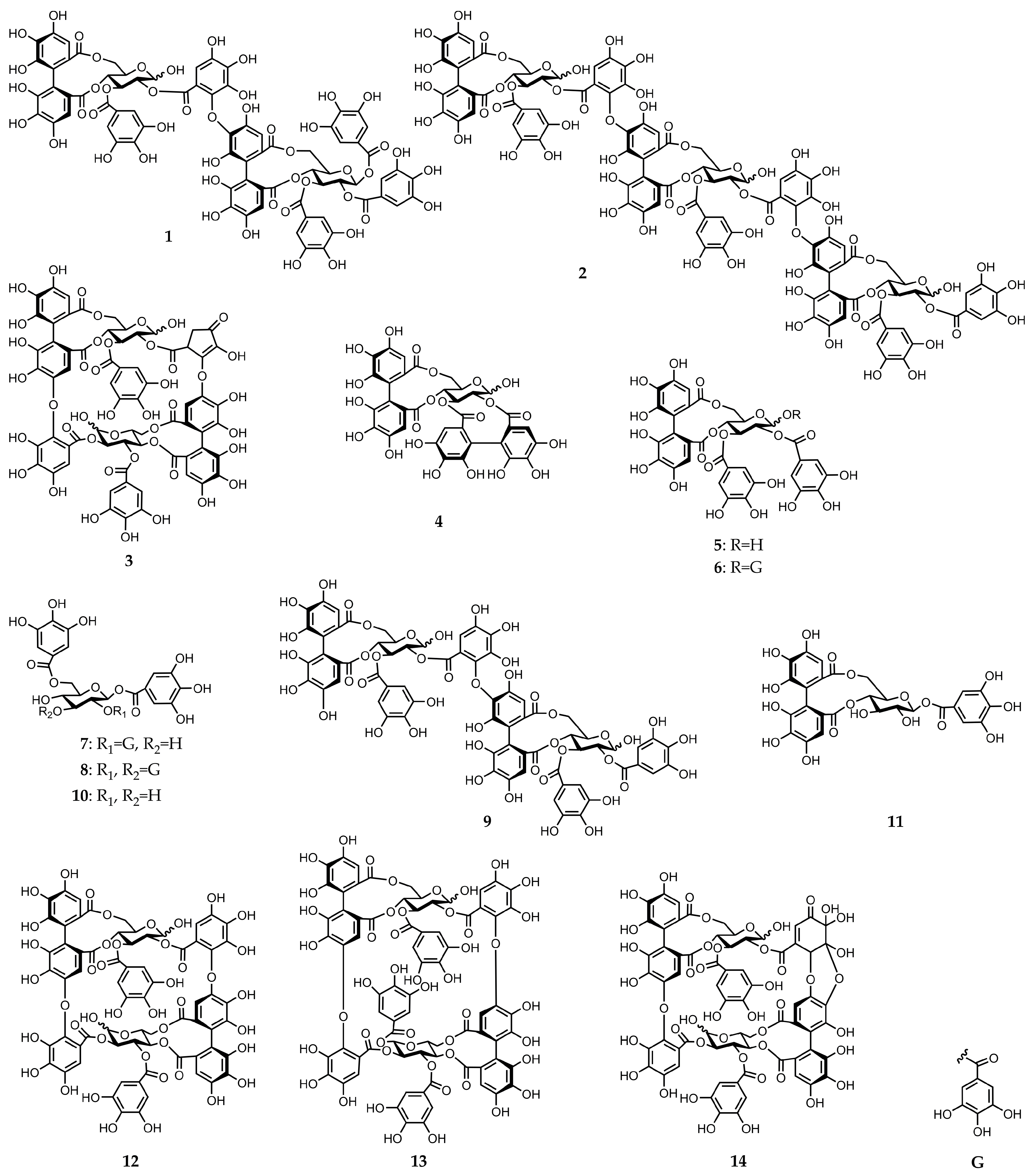
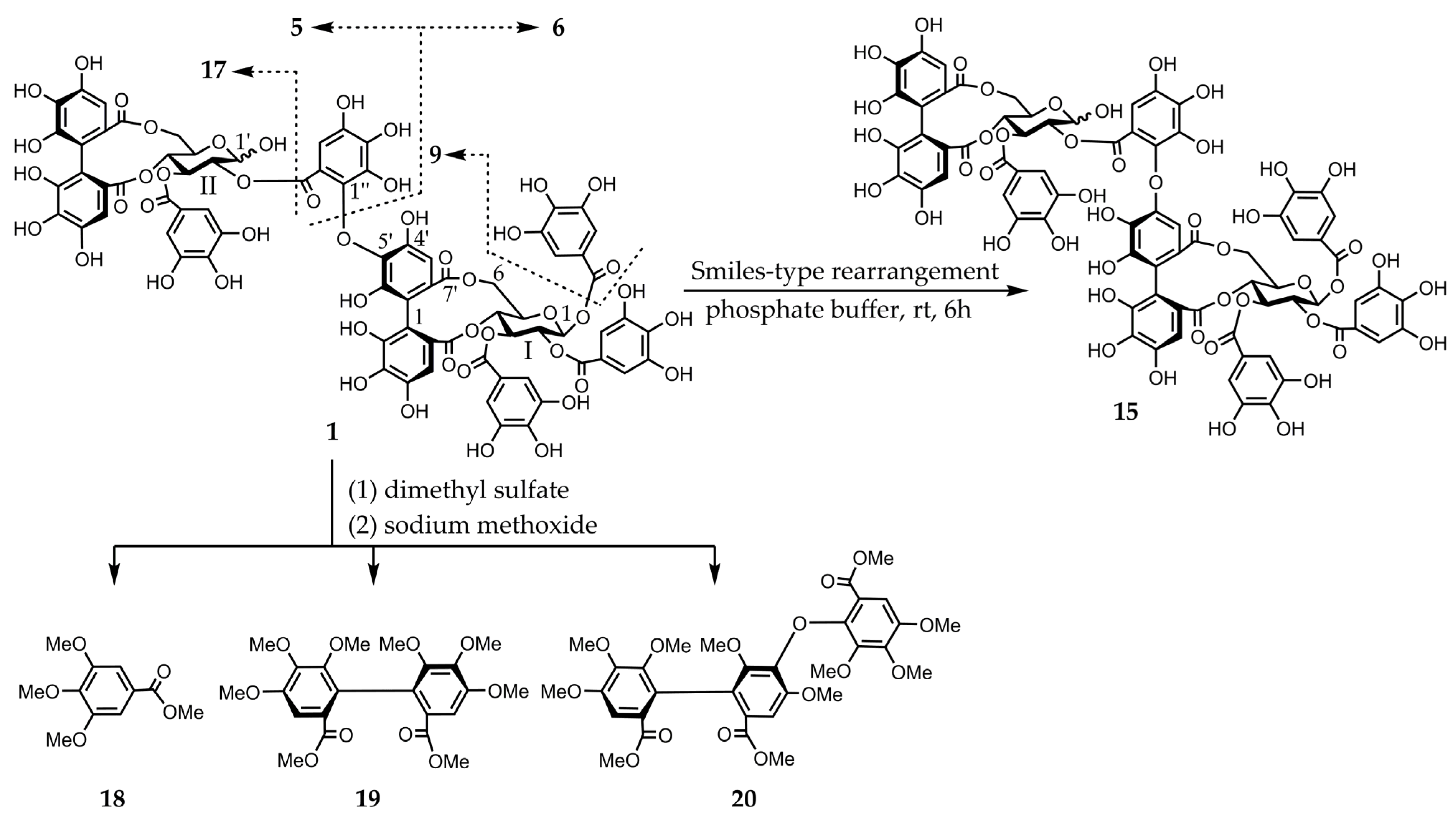
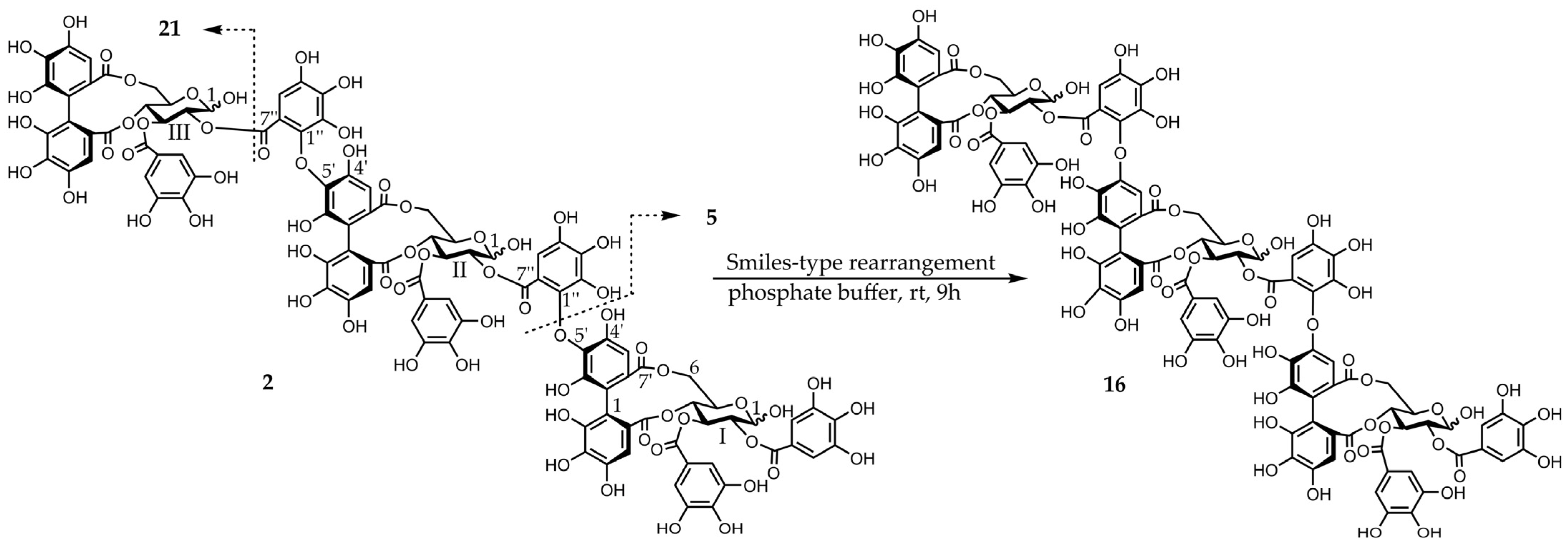
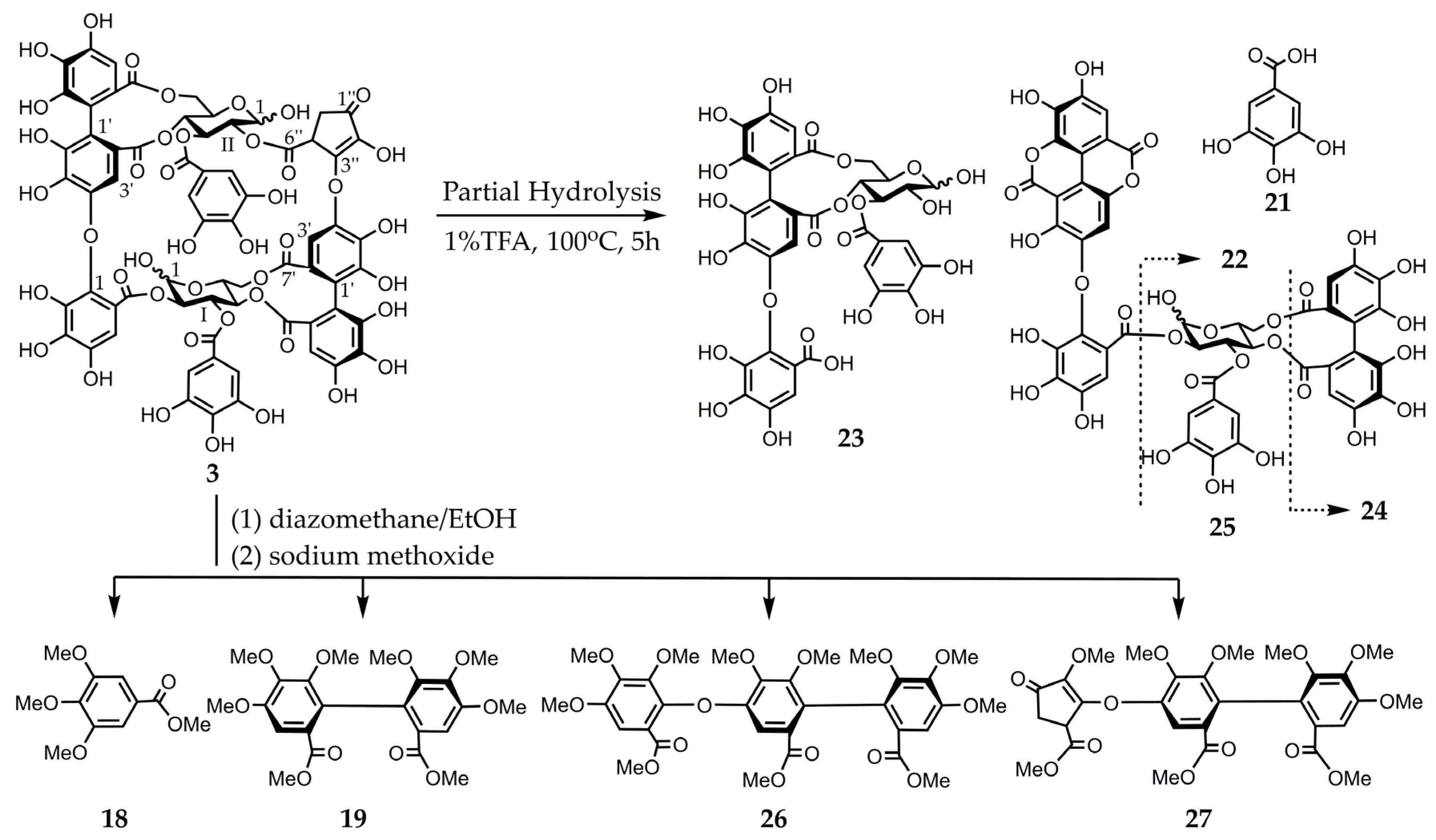

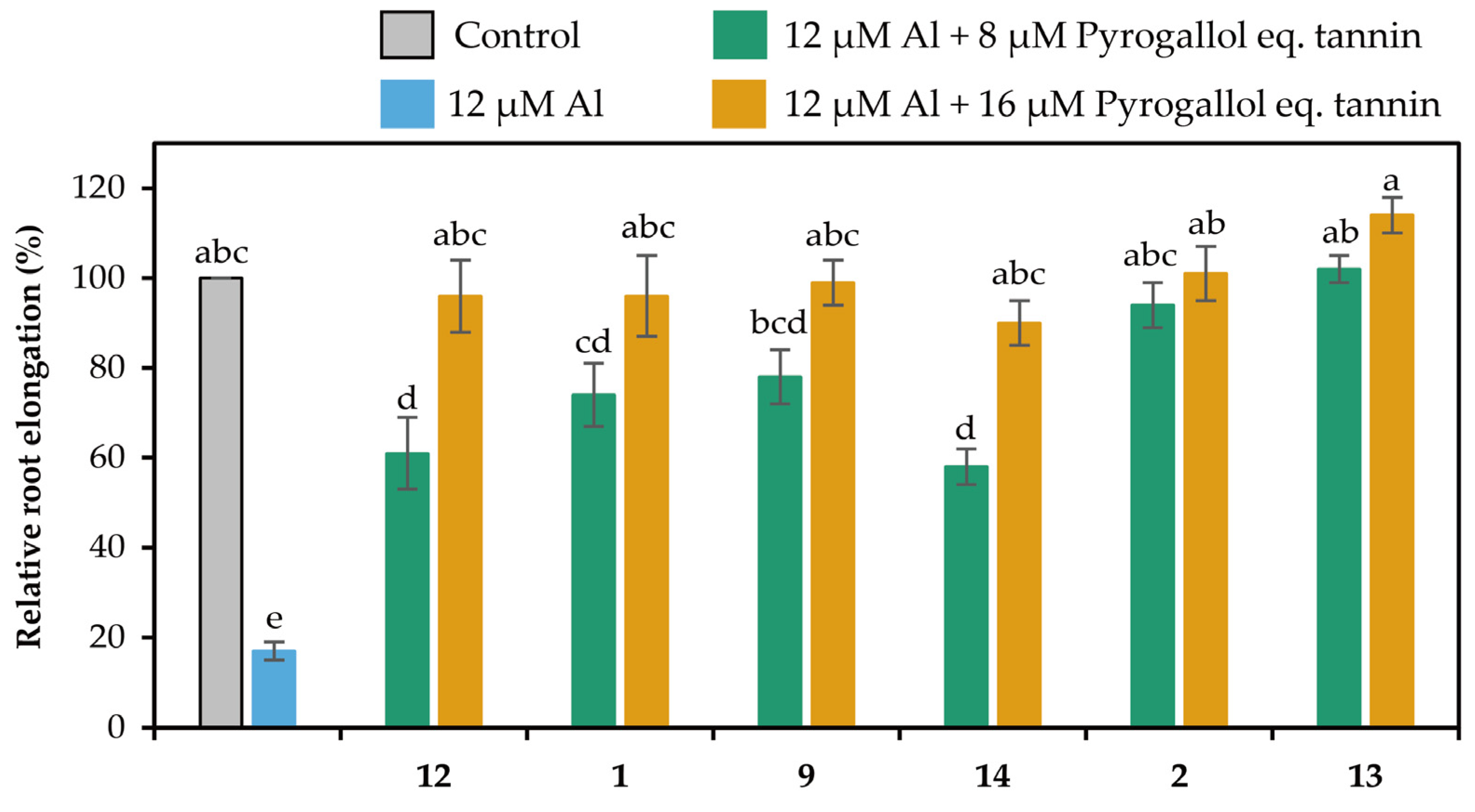
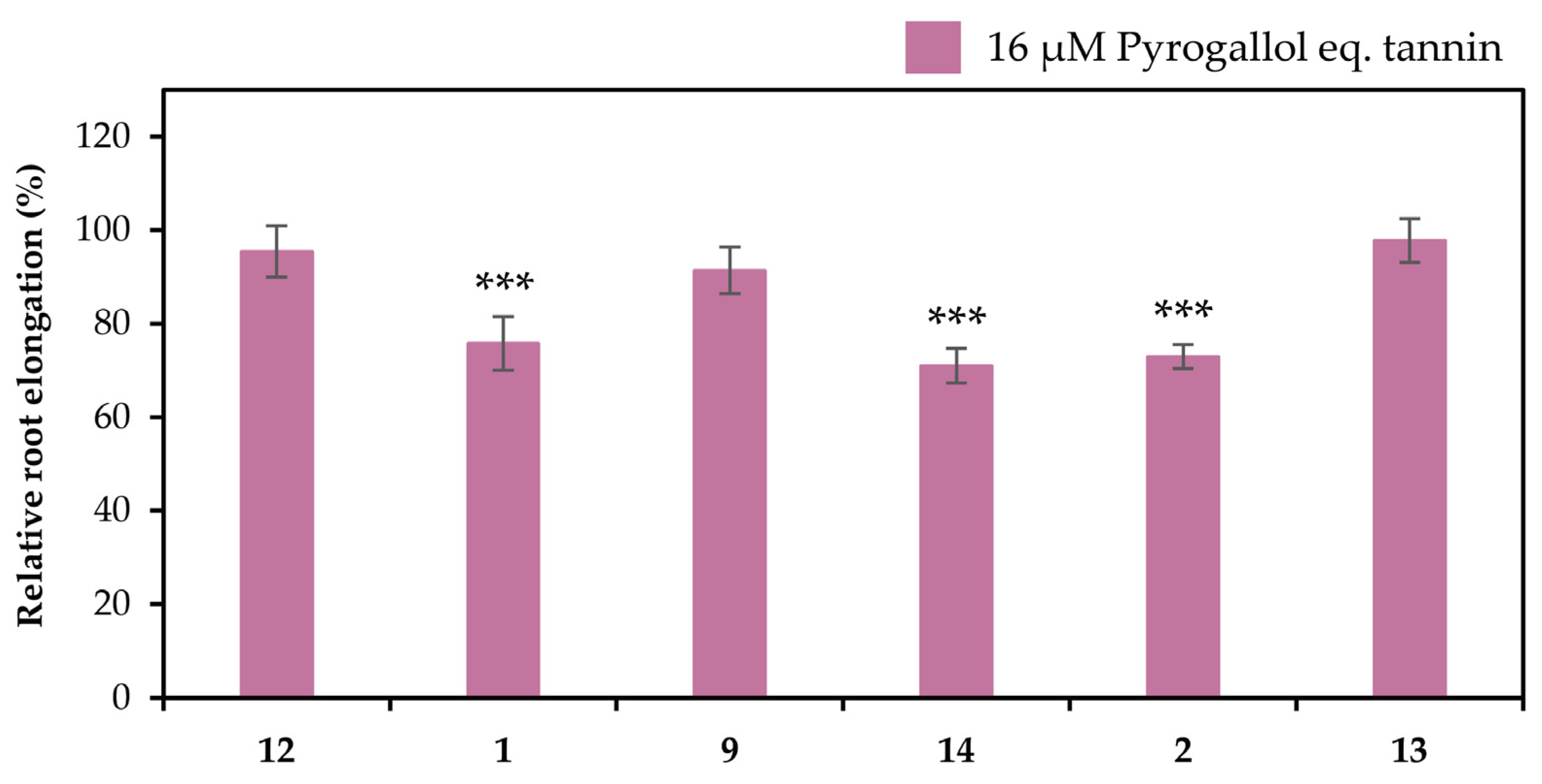
Disclaimer/Publisher’s Note: The statements, opinions and data contained in all publications are solely those of the individual author(s) and contributor(s) and not of MDPI and/or the editor(s). MDPI and/or the editor(s) disclaim responsibility for any injury to people or property resulting from any ideas, methods, instructions or products referred to in the content. |
© 2025 by the authors. Licensee MDPI, Basel, Switzerland. This article is an open access article distributed under the terms and conditions of the Creative Commons Attribution (CC BY) license (https://creativecommons.org/licenses/by/4.0/).
Share and Cite
Uemori, H.; Inoue, A.; Suzuki, S.; Iwaoka, Y.; Hatano, T.; Yoshimura, M.; Amakura, Y.; Murakami, T.; Tahara, K.; Ito, H. Ellagitannin Oligomers from Eucalyptus camaldulensis Leaves and Their Role in the Detoxification of Aluminum. Molecules 2025, 30, 2216. https://doi.org/10.3390/molecules30102216
Uemori H, Inoue A, Suzuki S, Iwaoka Y, Hatano T, Yoshimura M, Amakura Y, Murakami T, Tahara K, Ito H. Ellagitannin Oligomers from Eucalyptus camaldulensis Leaves and Their Role in the Detoxification of Aluminum. Molecules. 2025; 30(10):2216. https://doi.org/10.3390/molecules30102216
Chicago/Turabian StyleUemori, Haruna, Ayano Inoue, Shoichi Suzuki, Yuji Iwaoka, Tsutomu Hatano, Morio Yoshimura, Yoshiaki Amakura, Toshiyuki Murakami, Ko Tahara, and Hideyuki Ito. 2025. "Ellagitannin Oligomers from Eucalyptus camaldulensis Leaves and Their Role in the Detoxification of Aluminum" Molecules 30, no. 10: 2216. https://doi.org/10.3390/molecules30102216
APA StyleUemori, H., Inoue, A., Suzuki, S., Iwaoka, Y., Hatano, T., Yoshimura, M., Amakura, Y., Murakami, T., Tahara, K., & Ito, H. (2025). Ellagitannin Oligomers from Eucalyptus camaldulensis Leaves and Their Role in the Detoxification of Aluminum. Molecules, 30(10), 2216. https://doi.org/10.3390/molecules30102216






